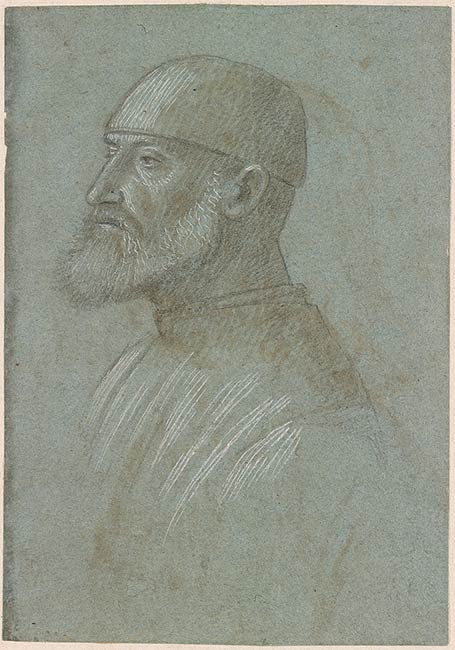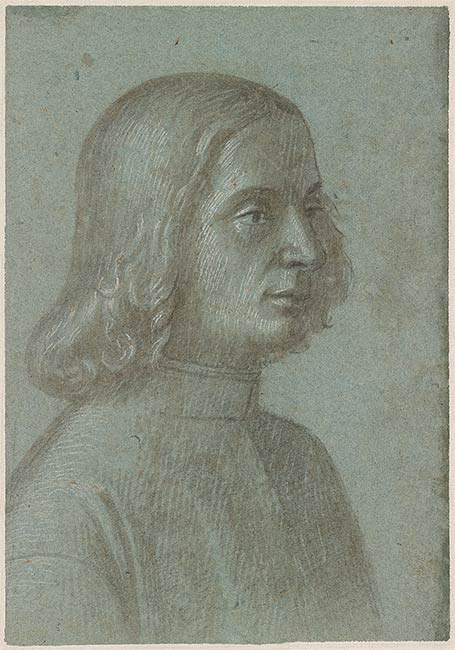

Best remembered for his lively narrative cycles for Venetian scuole as considered among the foremost painters of Renaissance Venice. He was also a highly accomplished draftsman, as witnessed by the more than fifty studies from his hand known today, which, by the standards of his period, is an unusually large oeuvre to have survived.1
Drawn lightly in brush and brown wash and white heightening on the blue paper so typical for Venice, this sheet bears two bust-length male portraits: one of an older bearded man wearing the cap and tunic of the Venetian quattrocento, and on the other side, drawn to a slightly larger scale, a young man with flowing, shoulder-length hair.2 In an attempt to create an impression of volume that accords with contemporary portrait painting practice in Venice, the sitters are posed in three-quarter view, their forms reduced to essentials silhouetted in black chalk against the blue background of the paper. The young man on the verso may initially have been posed in clearer profile before the artist applied more wash to the area of the chin, jowls, and hair at right, thereby turning the figure in the direction of the viewer. As in Carpaccio’s paintings, the figures are conceived as simple volumetric forms, restrained in gesture and, in Lauts’s words, exhibiting a “measured expression of controlled sentiment.”
A certain specificity of the sitters’ features, especially those of the older man on the recto of the sheet, suggests that the drawings may be portraits of contemporaries; one could even imagine a familial resemblance between the two. As in the case of other Carpaccio portrait drawings, such as the Young Man in a Cap in the Christ Church Picture Gallery, Oxford,3 and the Head of an Old Man in the Boijmans van Beuningen Museum, Rotterdam,4 which are closely comparable in style and handling, the exact purpose of the present sheet is not certain. Such portraits may have been created as individual likenesses to be painted or inserted into one of the artist’s narrative scenes, which are densely populated with portraits of contemporaries, or they may have been kept as stock figures of the painter’s repertoire to be used when the need arose. A sheet of studies at the Ashmolean Museum, Oxford, with female heads on both recto and verso, seems to have been drawn in connection with Carpaccio’s famous St. Ursula cycle of the 1490s (now in the Accademia, Venice), but Carpaccio reused the heads in his Presentation of the Virgin altarpiece of 1510 (San Giobbe, Venice).5 Similarly, Michelangelo Muraro associated the Morgan drawing, in particular the recto, with the St. Ursula cycle, though no exactly equivalent figure is apparent in the painting. Roger Rearick, in a letter of 2001, remarked upon a distinct resemblance between the head of the young man on the verso and the figure second from left just below the pier along the left side of the 1491 Apotheosis of St. Ursula, although this is not an entirely convincing comparison. Both Muraro and Rearick thus dated the drawing to the early 1490s, the period of the St. Ursula cycle, whereas Jan Lauts and Pietro Zampetti preferred a slightly later date of around 1500.6
—REP
Footnotes:
- For a recent, positive reappraisal of Carpaccio’s work as a draftsman, see Whistler 2016, chapter 7.
- Close examination by Margaret Holben Ellis revealed no evidence of retouching, as is sometimes claimed in the literature, for example in Lauts 1962, 274.
- Christ Church Picture Gallery, Oxford, inv. 0282. Byam Shaw 1976, 1: no. 710.
- Boijmans van Beuningen Museum, Rotterdam, inv. mb 1940/t 8. See Ger Luijten in New York and elsewhere 1990–91, no. 55.
- Ashmolean Museum, Oxford, inv. wa1977.17. See Oxford 2015–16, no. 4.
- Lauts 1962, no. 38; Zampetti in Venice 1963, no. 3.
Watermark: none.
Bonfiglioli, Silvestro, 1637-1696, former owner.
Bonfiglioli, Bartolomeo, former owner.
Sagredo, Zaccaria, 1653-1729, former owner.
Udny, John, 1727-1800, former owner.
Murray, Charles Fairfax, 1849-1919, former owner.
Morgan, J. Pierpont (John Pierpont), 1837-1913, former owner.
Morgan, J. P. (John Pierpont), 1867-1943, former owner.
Rhoda Eitel-Porter and and John Marciari, Italian Renaissance Drawings at the Morgan Library & Museum, New York, 2019, no. 56.
Selected references: Fairfax Murray 1905-12, 1: nos. 54-55; van Marle 1923-38, 18:350n1; Hadeln 1925, 40; Fiocco 1930, 68; New London 1936, no. 15; Toledo 1940, no. 77; Northampton 1941, no. 3; Mongan 1942, 94; Tietze and Tietze-Conrat 1944, under A600, and no. 627; Lauts 1962, no. 38; Muraro 1966, 110; Stockholm 1970, no. 30; Muraro 1977, no. 555; Sgarbi 1994, 232; White 1994, 1:100, 102-3; Rearick 2002, 46; Munich 2008-9, no. 6.
Collection J. Pierpont Morgan : Drawings by the Old Masters Formed by C. Fairfax Murray. London : Privately printed, 1905-1912, I, 54 and 55, repr.
100 Master drawings from the Morgan Library & Museum. München : Hirmer, 2008, no. 6, repr. [Rhode Eitel-Porter]
